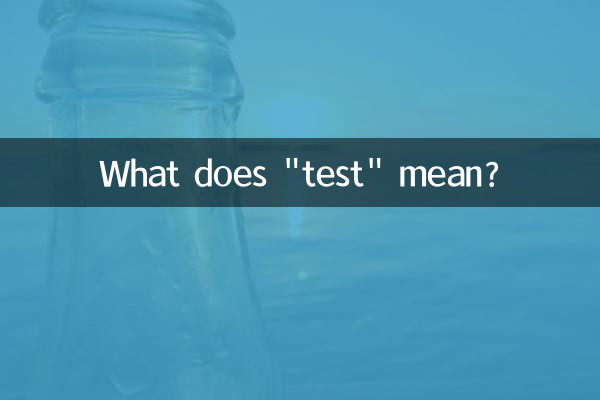What does "kao" in exam mean?
Examination is an inevitable part of everyone's growth process, but have you ever thought about the original meaning of the word "examination"? This article will give you a comprehensive interpretation of the deep meaning of "kao" from three perspectives: glyph evolution, word meaning analysis, and cultural connotation, combined with hot topics on the Internet in the past 10 days.
1. The evolution and basic interpretation of the glyph "kao"

| Glyph period | Feature description | meaning extension |
|---|---|---|
| Oracle | Like an old man leaning on a stick | Original meaning is "old" |
| Inscriptions on gold | Add hair features | Extended to "longevity" |
| Xiaozhuan | Line regularization | Develop the meaning of "assessment" |
It can be seen from the evolution of the glyph that "kao" was originally related to old age. "Shuowen Jiezi" records: "Kao means old age." Later, it derived meanings such as "complete" and "inspection". Modern Chinese mainly contains three meanings: 1. Test and test; 2. Research and inference; 3. Late father.
2. "Examination culture" reflected in hot spots across the Internet
| hot topics | Platform popularity | Related test points |
|---|---|---|
| Postgraduate Entrance Examination National Line Announced | Weibo hot search TOP3 | The social impact of selective examinations |
| AI cheating detection system | Zhihu hot discussion | Technical guarantee of exam fairness |
| Burden reduction policy for primary and secondary school students | Douyin views 120 million | Exam frequency and the nature of education |
Recent hot topics in the field of education reflect society's rethinking of the function of examinations: When a province announced the policy of "cancelling paper-based examinations in lower grades of primary schools", the related topic received more than 500,000 discussions within 24 hours. Those in favor believed that it was in line with the law of growth, while those opposed were worried about losing the learning feedback mechanism.
3. Analysis of the philosophical connotation of "kao"
From the Confucian classics, it can be seen that the ancients had a profound understanding of "examination": "The Analects" "I examine myself three times a day" reflects self-examination; "The Book of Rites" "examines the system and examines the gains and losses" emphasizes the function of system inspection. In the modern education system, "examination" contains at least three dimensions:
| Dimensions | ancient examples | modern embodiment |
|---|---|---|
| knowledge test | Imperial Examination Policy | Subject written examination |
| competency assessment | Six Arts Assessment | practice test |
| Moral examination | Recommended by filial piety and integrity | Comprehensive quality evaluation |
4. Comparison of examination forms from an international perspective
After the global epidemic, the examination format has changed significantly. The latest data shows:
| country | Examination Reform Initiatives | social response |
|---|---|---|
| Japan | Introducing AI interview system | Enterprise adoption rate reaches 67% |
| USA | SAT cancels essay test | Controversy over elite school admission standards |
| Finland | Comprehensive implementation of project-based evaluation | Teacher support rate 89% |
It is worth noting that the English word "exam" for "examination" is derived from the Latin word "examinere", which originally means "weighing". It is surprisingly consistent with the meaning of "weighing" in the Chinese word "kao", reflecting mankind's common pursuit of fair evaluation.
5. Development trends of future examinations
Combined with the cutting-edge trends in educational technology, it can be predicted that: 1) brain-computer interface may reshape examination formats; 2) blockchain technology will ensure the authenticity of results; 3) affective computing technology may be used for psychological quality assessment. But no matter how the form changes, the core value of "Kao" -Promote the all-round development of peopleThis essence should not change.
From the "old" in oracle bone inscriptions to the modern "test", the word "kao" carries the thousand-year thinking of Chinese civilization on knowledge inheritance and talent selection. Today, when both burden reduction and quality improvement are emphasized, we may need to return to the origin of the word "kao" - it is not only a measurement tool, but also a ladder to help growth.

check the details

check the details